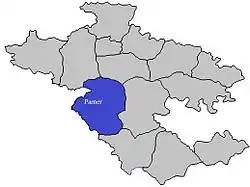Ralegan Siddhi
Ralegan Siddhi is a village in Parner taluka of Ahmednagar District, Maharashtra state in western India. It is located at a distance of 87 km from Pune. The village has an area of 982.31 ha (1991). It is considered a model of environmental conservation. The village has carried out programs like tree planting, terracing to reduce soil erosion and digging canals to retain rainwater. For energy, the village uses solar power, biogas (some generated from the community toilet) and a windmill.[1] The project is heralded as a sustainable model of a village republic.
Ralegan Siddhi | |
|---|---|
Village | |
 Ralegan Siddhi Location in Maharashtra, India  Ralegan Siddhi Ralegan Siddhi (India) | |
| Coordinates: 18.92°N 74.41°E | |
| Country | |
| State | Maharashtra |
| District | Ahmednagar |
| Government | |
| • Type | Panchayati raj (India) |
| • Body | Gram panchayat |
| Languages | |
| • Official | Marathi |
| Time zone | UTC+5:30 (IST) |
| PIN | 414302 |
| Telephone code | 02488 |
| Vehicle registration | MH-16 |
| Website | maharashtra |
The village's biggest accomplishment is in its use of renewable sources for energy. For example, all the village street lights each have separate solar panels.[2] The village is headed by a Sarpanch who is the chief of the Gram panchayat (village panchayat).
Demographics
In 2001, the village had 394 households with a total population of 2306 (1265 males and 1041 females).[3]
Watershed development
In 1975 the village was afflicted by drought, poverty prevailed, and trade in illicit liquor was widespread. The village tank could not hold water as the embankment dam wall leaked. Work began with the percolation tank construction. Anna Hazare encouraged the villagers to donate their labour to repair the embankment. Once this was fixed, the seven wells below filled with water in the summer for the first time in memory.[4]
Now the village has water year round, as well as a grain bank, a milk bank, and a school. There is no longer any poverty.[5]
Model village
The World Bank Group has concluded that the village of Ralegan Siddhi was transformed from a highly degraded village ecosystem in a semi-arid region of extreme poverty to one of the richest in the country. The Ralegan Siddhi example, now 25 years old, by demonstrating that it is possible to rebuild natural capital in partnership with the local economy, is a model for the rest of the country.[6]
Anna Hazare
Indian social activist Anna Hazare, leader of the village, is accredited in helping in the development of the village. He was awarded the Padma Bhushan—the third-highest civilian award—by the Government of India in 1992 for his efforts in establishing this village as a model for others.[7]
Notes
- "Anna Hazare". rainwaterhavesting.org. Retrieved 19 December 2006.
- "A model Indian village- Ralegaon Siddhi". Retrieved 30 October 2006.
- Kapur Mehta, Asha; Trishna Satpathy. "Escaping Poverty: The Ralegan Siddhi Case" (PDF). Chronic Poverty Research Centre and Indian Institute of Public Administration. p. 8. Archived from the original (PDF) on 23 July 2011. Retrieved 10 April 2011.
- "Ralegan Siddhi : A village Transformed". Retrieved 30 October 2006.
- "Special Report - The Value of Natural Capital". World Bank. Archived from the original on 31 December 2006. Retrieved 30 October 2006.
- "The Value of Natural Capital - Communities regenerate natural capital". World Bank Institute. Archived from the original on 31 December 2006. Retrieved 30 October 2006.
- "Padma Bhushan Awardees". Archived from the original on 23 April 2011. Retrieved 10 April 2011.
